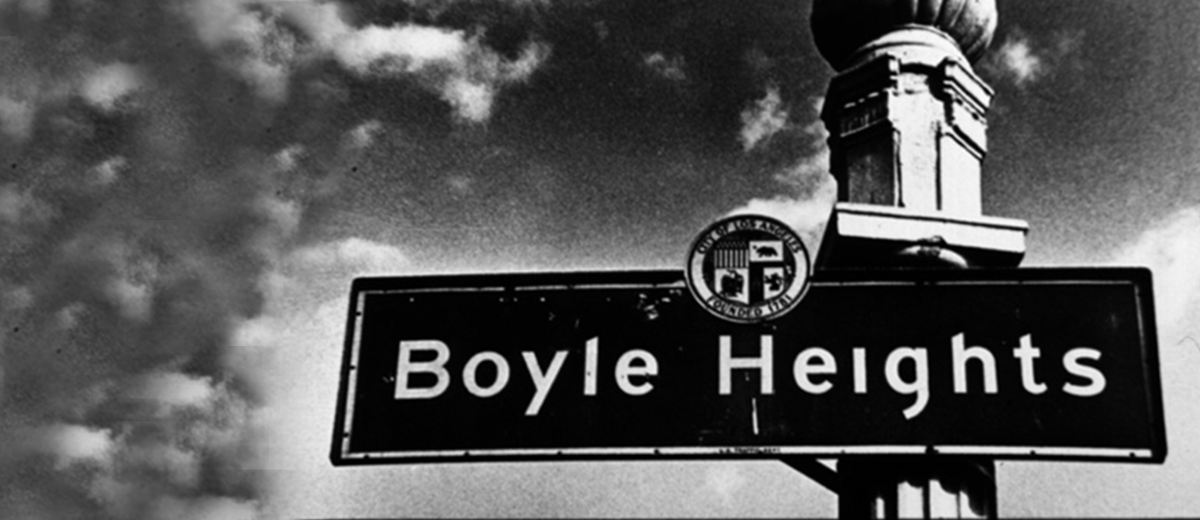
The Boyle Heights Project was designed to serve as a model for the collaborative research and documentation of community histories and experiences. The project and its programs are instructive for museums that want to work in partnership with the communities they serve and with other organizations.
Why did the Japanese American National Museum initiate this project?
The Japanese American National Museum has been working to become a new kind of museum—one that actively involves the people and communities it serves as equal partners. From its inception the National Museum has been, and continues to be community-based—conceived of, strongly supported by, and deeply connected to the Japanese American community. The Boyle Heights Project is one facet of the National Museum’s efforts and extends across disciplinary, generational, ethnic, and religious lines.

The International Institute of Los Angeles, The Jewish Historical Society of Southern California, Self-Help Graphics, Theodore Roosevelt Senior High School, and an advisory group of scholars, community experts, and the Japanese American National Museum are partners in this interdisciplinary initiative that encompasses new research, an exhibition, and an extensive series of public programs.
Project Vision Statement
The entire Boyle Heights Project creates opportunities for people of diverse ethnic and generational backgrounds to learn about one another’s experiences and histories, recognize how these converge or diverge, and consider their lives in contexts that extend beyond their immediate neighborhood, ethnic, or social groups. The hope is that such learning processes and exchanges will provide ideas and insights for better understanding the present and the changes that affect all communities. By understanding and discussing the processes of neighborhood change and continuity—the causes and consequences on people’s everyday lives—we can thoughtfully contextualize and therefore more meaningfully address the neighborhood’s current conditions and problems.

A central part of this initiative is the development of sustainable partnerships. The Japanese American National Museum hopes that the efforts started in the Boyle Heights Project will continue as part of the activities of all the partnering organizations. Above all, we hope that the partnership experience will promote lasting intercultural relations and linkages between participating organizations and communities. We expect that by working together, the partners will reinforce each other’s involvement in Boyle Heights and that the expertise and information shared will inform how each develops future programs and projects.
Project Goals
- Promote collaborations and intercultural exchanges amongst organizations, scholars, and community members;
- Document, interpret, and share the history of the diverse communities of Boyle Heights through the voices and perspectives of those who live/d there;
- Engage and challenge individuals and organizations to participate in civic dialogue that connects the stories of past and present neighborhood residents, as well as those of people from different ethnic/racial backgrounds.
Project Components
- Community outreach and collaboration through: oral history interviews, presentations and forums in the community, high school research project, neighborhood programs, and artifact and photograph collection activities.
- Cultural history exhibition, Boyle Heights: The Power of Place at the Japanese American National Museum (September 8, 2002 – February 23, 2003)
- Contemporary art exhibition, About, By, From: Boyle Heights—Expressions, Impressions and Memories of a historic neighborhood in East Los Angeles at Self-Help Graphics & Art (September 8 – October 13, 2002)
- Public program series
Project Partners
Japanese American National Museum
Irene Hirano, Executive Director & President
Audrey Lee-Sung, Sojin Kim, Darcie Iki, Claudia Sobral, Emily Anderson—Core Project Team
Self-Help Graphics & Art
Tomas Benitez, Executive Director
International Institute of Los Angeles
E. Stephen Voss, President & CEO
Joy Hofer, Vice President
Jewish Historical Society of Southern California
Stephen J. Sass, President
Jerry Freedman-Habush, Board Member
Toby Horn, Board Member
Theodore Roosevelt Senior High School
Henry Ronquillo, Principal
Ron Hirosawa, Assistant Principal
PROJECT ADVISORS
Felicia Acosta
Abe Alvarez
Butch Bablot
Kate Bolotin
Lonnie G. Bunch
Kenneth C. Burt
Ron Chew
Hortensia & Joe Corral
Helena Cota
Margaret Crawford
Lucy Delgado
Victor & Rebecca Delgado
Hershey Eisenberg
Elva Flores
Oscar Florez
Dave Fuentes
Ruben Guevara
Rosalie Gurrola
Saburo Hori
Albert Johnson, Jr.
Daniel Kawahara
Moira Kenney
George Lipsitz
Sharon Maruya
Kathy Masaoka
Valerie Matsumoto
Mollie Murphy
Don Nakanishi
Alvaro Rodriguez
James Rojas
Vicki L. Ruiz
Leland Saito
George Sanchez
Howard Shorr
Roland Silva
John Kuo Wei Tchen
Raul Vasquez
Bud Weber
Dianna Ybarra-Tiscareno
Annie & Paul Zolnekoff
Funders
This project is funded by members and donors of the Japanese American National Museum; the California Council for the Humanities, a state affiliate of the National Endowment for the Humanities, in partnership with the James Irvine Foundation; University of Southern California SC/W Exposition; The John Randolph Haynes and Dora Haynes Foundation; the Institute for Museum and Library Services; the National Endowment for the Humanities; The Nathan Cummings Foundation; Nissan Foundation and the Bank of America Foundation.
Photos: A gathering of both Molokan conscientious objectors and servicemen at the United Molokan Christian Association, Utah Street, 1943. Courtesy of Paul and Andy Patapoff (2000.211.4); Carol Komatsuka at family gravesite, ca. 1950. Collection of Carol Komatsuka (21.2001.16)
